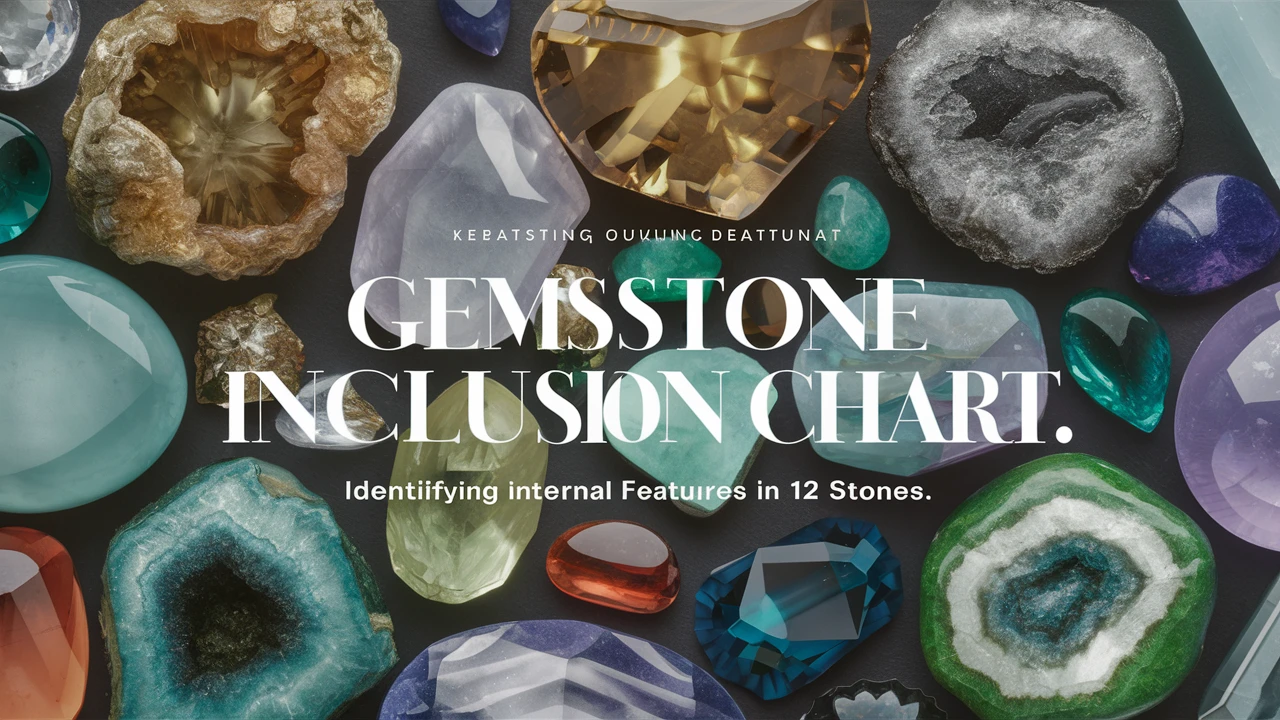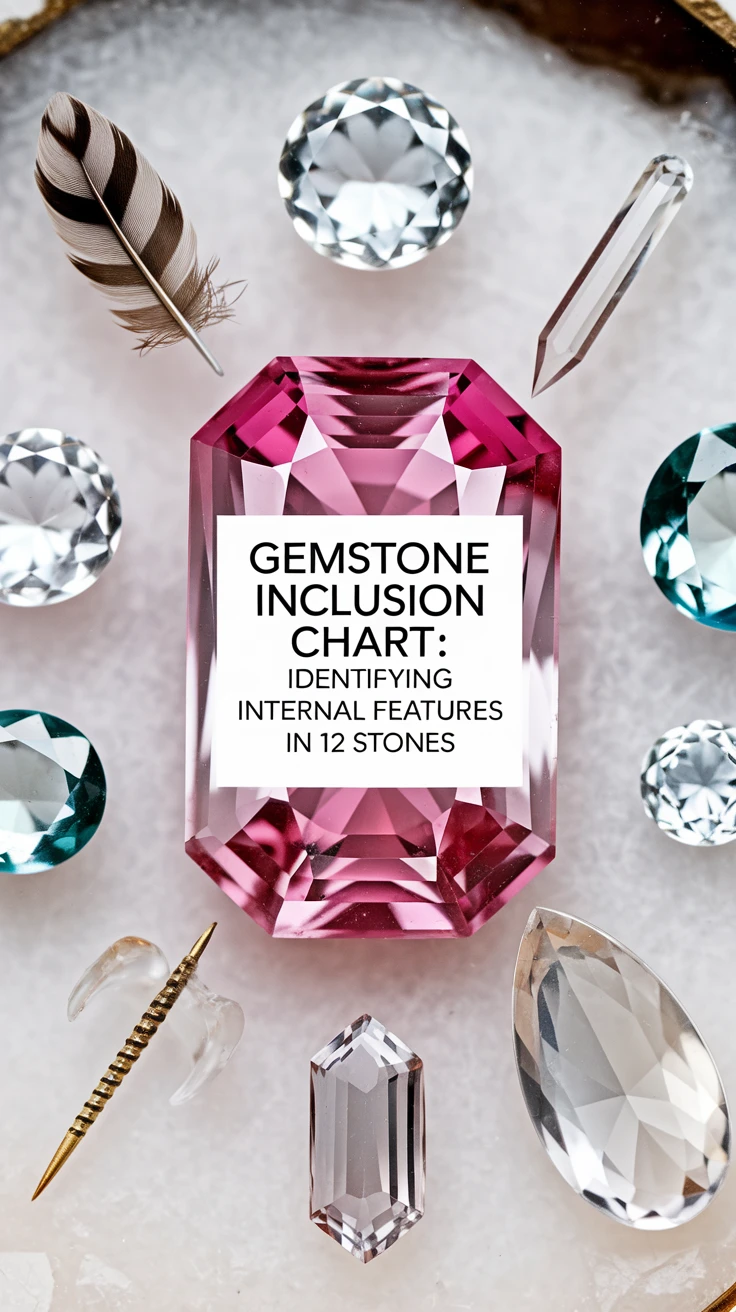
For gemologists and jewelry enthusiasts alike, understanding gemstone inclusions is like reading nature’s fingerprints. These internal features tell fascinating stories about a stone’s formation, authenticity, and origin. Whether you’re a professional gemologist or a curious collector, this comprehensive guide will walk you through the characteristic inclusions of 12 popular gemstones, helping you develop a keen eye for these microscopic treasures that make each stone unique.
Understanding Gemstone Inclusions
Before diving into specific stones, let’s understand what inclusions are and why they matter. Inclusions are internal features that formed during a gemstone’s creation, ranging from tiny crystals to liquid-filled cavities. While some may view them as imperfections, these characteristics are essential for authenticating natural stones and distinguishing them from synthetic alternatives.
| Inclusion Type | Description | Common in |
|---|---|---|
| Needle inclusions | Fine, elongated crystal structures | Ruby, Sapphire |
| Fingerprints | Healing fissures resembling fingerprints | Emerald, Ruby |
| Crystal inclusions | Mineral crystals trapped within | Diamond, Garnet |
| Fluid inclusions | Liquid-filled cavities | Quartz, Topaz |
Essential Tools for Inclusion Identification
Success in inclusion identification relies heavily on having the right tools and knowing how to use them properly. Here’s what you’ll need:
| Tool | Purpose | Recommended Specifications |
|---|---|---|
| Loupe | Quick examination | 10x magnification, triplet |
| Microscope | Detailed analysis | 10x-60x magnification |
| Fiber optic light | Focused illumination | Dual-arm, adjustable |
| Immersion cell | Enhanced visibility | Glass container with optical fluid |
The 12 Most Common Gemstones and Their Inclusions
1. Diamond
Diamond inclusions, known as “characteristics,” often appear as crystal inclusions, feathers, or clouds. The most distinctive are octahedral crystal inclusions and graphite spots. Look for needle-like features and graining patterns under crossed polarizing filters.
2. Ruby
Rutile silk and fingerprints are hallmark inclusions in natural rubies. The silk appears as fine, intersecting needles forming a six-sided pattern. Healing fissures create characteristic fingerprint patterns that help authenticate natural stones.
3. Sapphire
Similar to rubies, sapphires often contain rutile silk, but may also show distinctive hexagonal growth patterns and color zoning. Crystal inclusions of zircon with stress halos are particularly diagnostic.
4. Emerald
The famous “jardin” (garden) of emeralds consists of three-phase inclusions containing liquid, gas, and crystals. Look for characteristic fingerprints and parallel growth tubes.
5. Tanzanite
Distinctive plate-like inclusions and growth tubes are common. Trichroic pleochroism can be observed using polarized light, showing blue, purple, and bronze colors.
6. Aquamarine
Hollow tubes and liquid inclusions are characteristic. Two-phase inclusions containing liquid and gas are common, often appearing as elongated channels.
7. Peridot
“Lily pad” inclusions are distinctive, featuring disk-shaped stress halos around crystal inclusions. Look for characteristic “fingerprints” and chromite crystals.
8. Garnet
Horsetail inclusions in demantoid garnets are highly diagnostic. Other varieties show distinctive crystal inclusions and growth patterns.
9. Opal
Natural opals often show characteristic “snake skin” patterns and columnar structures. Flash effect and play-of-color patterns help authenticate natural stones.
10. Topaz
Two-phase inclusions and distinctive healing fissures are common. Look for characteristic “fingerprints” and liquid-filled cavities.
11. Amethyst
Tiger-stripe inclusions and phantom crystals are distinctive. Growth zones and liquid inclusions help authenticate natural stones.
12. Pearl
While not technically inclusions, growth structures visible under magnification help authenticate natural pearls. Look for characteristic concentric rings and organic structures.
Best Practices for Inclusion Analysis
Safety Precautions
- Always handle stones with clean, dry hands
- Use proper lighting to avoid eye strain
- Secure stones properly during examination
- Keep tools clean and well-maintained
- Work in a well-ventilated area when using immersion fluids
Documentation Tips
- Photograph significant inclusions
- Map inclusion locations
- Record lighting conditions used
- Note magnification levels
- Maintain detailed examination records
Conclusion
Understanding gemstone inclusions is crucial for anyone serious about gemology or jewelry collecting. These internal features not only help authenticate stones but also tell fascinating stories about their formation. By familiarizing yourself with characteristic inclusions in different gemstones, you’ll develop a deeper appreciation for these natural wonders and become more confident in your ability to identify and evaluate them.
Key Takeaways
- Inclusions are natural features that help authenticate gemstones
- Proper tools and lighting are essential for accurate identification
- Each gemstone type has characteristic inclusion patterns
- Documentation and careful observation are key to successful analysis
Frequently Asked Questions
What are gemstone inclusions?
Gemstone inclusions are internal features that formed during the stone’s creation, including crystals, liquids, or structural characteristics that can help determine authenticity and origin.
Do all natural gemstones have inclusions?
Yes, virtually all natural gemstones contain some form of inclusions, though they may not always be visible to the naked eye.
Are inclusions always a negative feature?
No, inclusions are valuable diagnostic tools and can sometimes enhance a stone’s value, particularly when they create unique effects or prove authenticity.
What magnification is best for viewing inclusions?
A 10x loupe is standard for initial examination, but microscopes with 10x-60x magnification are ideal for detailed analysis.
Can synthetic stones have inclusions?
Yes, synthetic stones can have inclusions, but they typically show distinctive patterns that differ from natural inclusion characteristics.
How do I document gemstone inclusions?
Use photography, detailed sketches, and written descriptions noting location, appearance, and viewing conditions.
Can inclusions affect a gemstone’s durability?
Yes, large or numerous inclusions can impact a stone’s durability and resistance to damage during setting or wear.
What lighting is best for viewing inclusions?
Fiber optic lighting provides the best control and visibility, though darkfield illumination is also valuable for certain types of examination.
Can inclusions help determine a gemstone’s origin?
Yes, certain inclusion patterns can be characteristic of specific geographic origins, helping gemologists determine a stone’s source.
Should I avoid buying gemstones with inclusions?
No, inclusions are natural features that can authenticate a stone. The impact on value depends on their type, size, and visibility.

